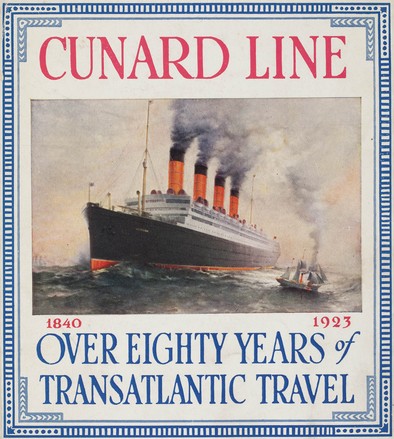Over eighty years of trans-Atlantic travel: a pictorial history showing the progress of Cunard, 1922
Cunard
Steamship Co.
Printed
booklet
Bayldon/0202
The Cunard
Line, one of the world’s greatest fleets of ocean going vessels, commemorates
the 175th anniversary of its first trans-Atlantic crossing in July
2015.
The history of
the Cunard fleet is the story of crossing the North Atlantic by sail, steam and
diesel, in vessels made from wood, to iron and steel.
Nova Scotian
Samuel Cunard was awarded the first British trans-Atlantic steamship mail
contract in 1839. With famous Scottish steamship designer and builder, Robert
Napier, the men launched four paddle steamers on the Liverpool-Halifax-Boston
route. These first mail steamers evolved into the massive luxury liners,
floating palaces and ocean-going holiday resorts of the modern tourist’s world.
Cunard’s Laconia began its first
around-the world cruise in January 1923, lasting 130 days and visiting 22
ports.
The first Cunarder
By Margot Riley
The first
Cunarder was the Britannia, ‘a plain
and comfortable boat’ which crossed the Atlantic in a fortnight, marking a
revolution in communication at a time when mail could take six weeks to reach
its destination. The shipalso
carried 115 first class passengers, 89 crew, 600 tons of coal, a cow to provide
fresh milk and three cats to keep down the rats. Within a decade the Line was crossing the
Atlantic on a weekly basis, ferrying over 5 million emigrants to America
between 1860 and 1900.
It has long
been customary for shipping lines to have a common theme for naming their
ships; the Cunard line used geographical regions ending in ‘ia’ such as Arcadia, Britannia, Franconia and Laconia, while the White Star Line named
their ships ending in ‘ic’, the most famous being the 1870s vessel Oceanic and the ill-fated RMS Titanic.
The White Star
Line focused on the UK-Australia trade, which increased swiftly after the
discovery of gold in 1850, and also began operating between New York and
Liverpool in the 1870s. White Star was committed to comfort and reliability
rather than to speed; the Celtic
cruised at 16 knots (30 km/hr) while Cunard’s Mauretania made 24 knots (44 km/hr). It was also the first shipping
line to have passenger ships with inexpensive accommodation for third-class
passengers. Its Oceanic-class of liners (1870-1872) carried up to 1,000
passengers increasing to 2,000 with the introduction of its “Big Four”
Olympic-class ocean liners between 1901 and 1907.
Francis Joseph Bayldon (1872–1948)
Francis Joseph
Bayldon was a master mariner and nautical instructor whose
extensive nautical collection, comprising some 900 items, has been part of the
Mitchell Library collection since the mid 1940s.
'The doyen of
Australian seafarers', Bayldon retired from the merchant service in 1910,
highly qualified in all branches of seamanship, a marine surveyor and a compass
adjuster. On 3 May 1910, he opened the Sydney Nautical Academy (later the
Sydney Nautical School) ‘catering for all types of nautical certificates and
later on for Civil Aviation licences as well'; he had some 3000 successful
students. In 1947, he sold the school to Captain W. D. Heighway and it later
formed the basis of navigation studies at Sydney Technical College. Ardently
interested in maritime history and exploration, Bayldon was also a fellow of
the Royal Australian Historical Society.



 Back to list
Back to list